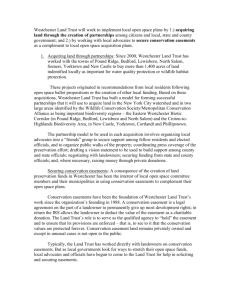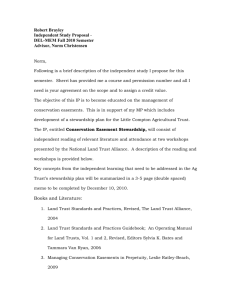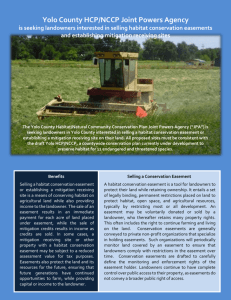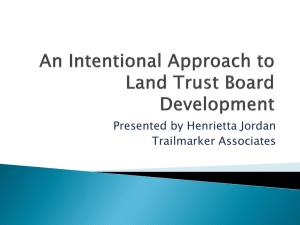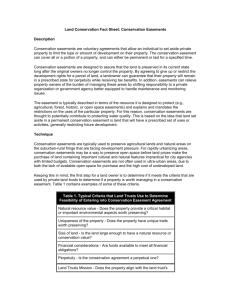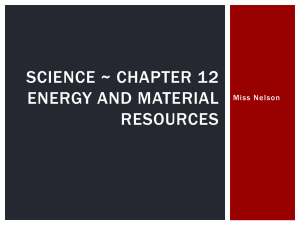Penelope Pierce - Montana Association of Land Trusts
advertisement
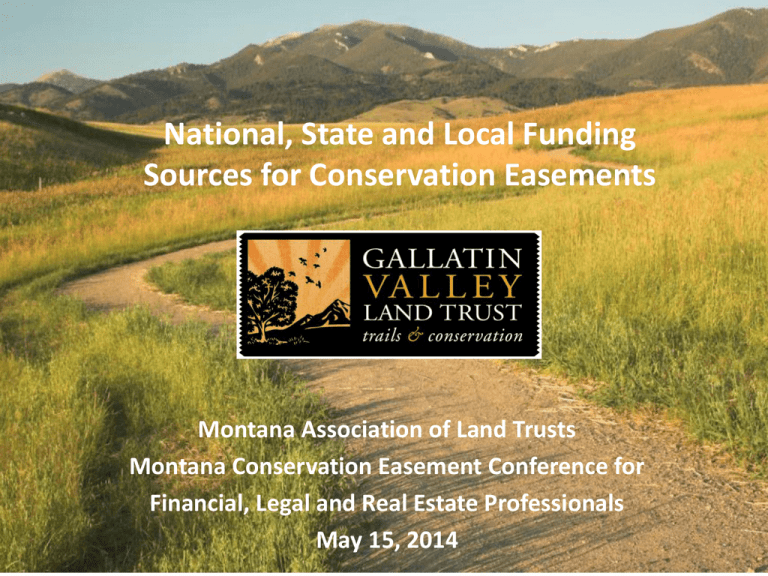
National, State and Local Funding Sources for Conservation Easements Montana Association of Land Trusts Montana Conservation Easement Conference for Financial, Legal and Real Estate Professionals May 15, 2014 Outline • Gallatin Valley Land Trust • Purchased vs. Donated Conservation Easements – Trends - Montana and National – General rule on Incentives – Purchasers – Land trust role in purchasing easements • Funding Opportunities – Public: Local, Regional, Federal – Private: Mitigation banks, foundations • Case Studies Gallatin Valley Land Trust • Since 1990 - 501(c)(3) non-profit • 43,000 acres conserved • 70+ miles of trails • Accredited • Solid financial footing • Professional staff • 2,000+ members • Serving Gallatin Valley and beyond Trends in Private Land Conservation 2010 National Land Trust Survey: • Acres conserved by local, state & national land trusts in US = 47M • 41% increase in acres conserved from 2005 to 2010 in MT • There are 13 land trusts in MT General Rules on Incentives Fully Donated & Costs Covered by Landowner Simple/ Flexible Few Weeks/ Months Fully Purchased & No Costs Covered by Landowner Conservation Easement Terms Number of Parties with Interest Time to Complete Transaction Rigid/ Complex Many Months/ Years Who Funds Purchased CE’s? Public – Cities/Counties – State – Federal Government Private – Foundations – Individuals What Do They Have in Common? • Seek to protect a natural resource value – Soil and Ag Land – Water – Wildlife – Scenic Views – Public Access • Want to see their investment leveraged What Role Can Land Trusts Play in Purchased Easement Programs? • Match landowner intent with funder interest and financial capacity • Assist the funding source by ensuring strategic investments Local/Regional Public Funding Sources 2010 : 83% of land conservation ballot measures passed nationwide, providing over $2 billion for conservation County Open Lands Programs – Gallatin – Lewis & Clark – Missoula – Ravalli County Open Lands Programs Gallatin County County Open Lands Programs Gallatin County Criteria: • Prime agricultural land • Large properties • Positive social/economic impacts • Wildlife habitat and movement corridors • Riparian areas and wetlands Process: • Proposals reviewed by Open Lands Board and County Commissioners State Public Funding Sources State Funding Sources Montana Fish Wildlife & Parks • Habitat Montana Offers incentives to landowners to conserve habitat on private land Federal Funding Sources Overview • Natural Resources Conservation Service • ACEP - Agricultural Conservation Easement Program • Farm and Ranchland Protection Program (FRPP) • Wetland Reserve Program (WRP) • Grassland Reserve Program (GRP) • Land & Water Conservation Fund (LWCF) • Forest Legacy • US Fish & Wildlife Service • North American Wetland Conservation Act (NAWCA) Federal Funding Sources ALE Program Goal: Keep productive farm and ranchland in agricultural use through conservation easements. Program Criteria: • Be privately owned • Meet one of three eligibility requirements • Contains crop land, grassland, pasture land or forest that contributes to the economic viability of an ag operation Federal Funding Sources WRE (formerly Wetland Reserve Program) Provides funds to restore wetlands while protecting them with a conservation easement. Federal Funding Sources Land & Water Conservation Fund (LWCF) • Created in 1965 • Uses revenues from offshore oil and gas leasing and reinvests them in onshore conservation Federal Funding Sources Forest Legacy • Voluntary program of US Forest Service • Provides grants to states for the purchase of easements and fee acquisition of environmentally-sensitive or threatened forest lands. Federal Funding Sources N. American Wetland Conservation Act (NAWCA) • Goal is to protect habitat for wetlands-associated migratory birds and other wildlife. Mitigation Funding Sources Mitigation Funding Sources Montana Aquatic Resources Services (MARS) • Funds projects to offset impacts to aquatic resources from development Mitigation Funding Sources Mitigation Funding Sources Montana Aquatic Resources Services (MARS) Bonneville Power Fish Mitigation Case Studies Photo: Yellowstone Ranch Preserve Flikkema Ranch Conservation Easement • 636 acre mix of prime ag land & wildlife habitat • Family-farmed for over 100 years • Easements completed in 2013 Conservation Values • 59% important soils • Important wildlife habitat • Headwaters of Camp Creek • Scenic ridgeline – Norris Road • 12 conservation easements within 7 miles Easement Terms • No divisions • One existing primitive cabin allowed • One new residence allowed • Agricultural operations and recreation allowed Funding • Bargain Sale Easement partial purchase partial donation Madison River Ranch Conservation Easement • 200 acres of important bird & wildlife habitat with Madison River frontage • Protects views of Missouri Headwaters region Landscape Position - Near Three Forks & Headwaters State Park - National Audubon Important Bird Area - I-90 View shed - Madison River Protection - Headwaters Trail System Three Forks - Near other public/conserved land Conservation Values • National & State Priority Bird Conservation Area • 32% prime soils on ag land • Abundant wildlife • Cultural area of state and national significance • Madison River/Missouri Headwaters protection Easement Terms • No divisions of property • One existing residence allowed • One new guest/caretaker residence allowed • Continued agricultural operations allowed Funding • Bargain Sale Easement partial purchase partial donation Oyler Conservation Easement • 590 acres of agricultural land, wildlife habitat and riparian corridor • Protects West Gallatin River Three Forks Conservation Values • Gallatin River protection • National & State Priority Bird Conservation Area • Public access on portion of property • Abundant wildlife • Scenic views from Dry Creek Road • Long-time ranching family Easement Terms • One division allowed • Continued agricultural operations allowed • No residences on easement property Funding Funding • Bargain Sale Easement partial purchase partial donation Thank you and questions www.gvlt.org


